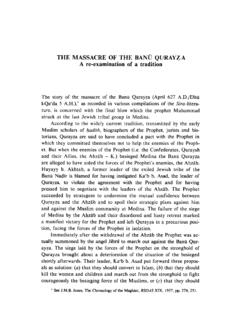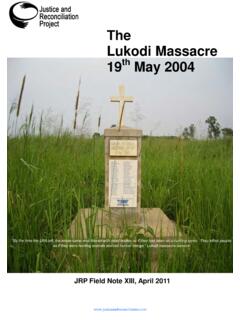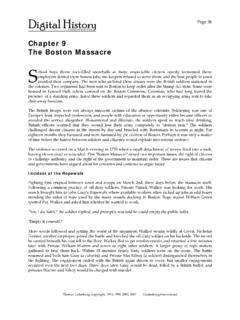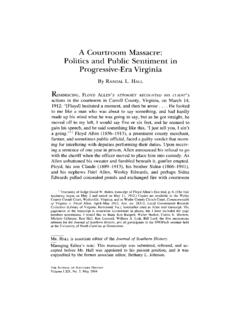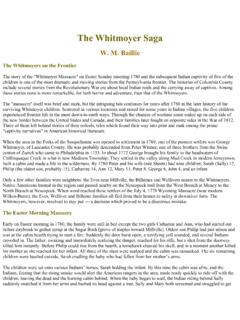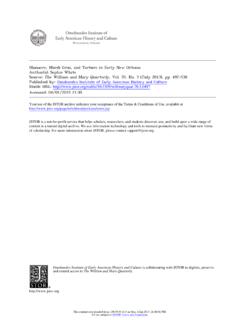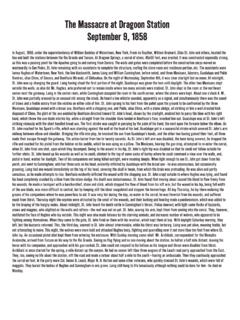Transcription of The Wyoming Massacre and Columbia County
1 The Wyoming Massacre and Columbia County by William Baillie The year 2003 marks the 225th anniversary of the Battle of Wyoming and the infamous Wyoming Massacre during the Revolutionary War. On July 3, 1778 a contingent of about 300 American militia met a much larger invading army of British regulars, Tories and Indians in the Wyoming Valley near modern Exeter south of Scranton. The Americans were overwhelmed and driven into a panicked retreat, with the Indians scalping every soldier they could lay hands on. The several American forts in the Valley were surrendered or abandoned; the invaders killed many civilians and destroyed houses, crops, and cattle. As news of the " Massacre " spread along the River, settlers in the Valley (more than 3000) fled in panic, joined by thousands more from the whole of the North Branch and West Branch regions of the Susquehanna, in what came to be known as the Great Runaway. While few if any men from the area of modern Columbia County fought in the Battle itself, this region was directly involved in the events which led up to and followed from the Massacre .
2 Local forts, fighters, and families played heroic roles in the struggle to cast off British rule and claim the frontier lands. Among the most noted local names were Lieutenant Moses VanCampen, Captain Lazarus Stewart and pioneer settler James McClure. All three owned lands in the Bloomsburg-Orangeville area; the latter two were brothers-in-law, married to sisters Martha and Mary Espy. Early in 1776, a Committee of Safety was set up in then-Northumberland County , a huge territory which included all the land in the Forks of the Susquehanna. Wyoming Township, which included modern Columbia County , was represented on the Committee by James McClure (of later Bloomsburg), Thomas Clayton of Catawissa, and Peter Mellick of Fishing Creek. The Committee raised a regiment to join Washington s army near Boston, and one of the early recruits was nineteen-year-old Moses VanCampen, whose family had recently settled on Fishing Creek. James McClure, however, knowing that young VanCampen was a crack shot and expert scout, persuaded him to stay and enroll in the Northumberland militia to help protect the local settlers.
3 Forts in Columbia County As a key defense to fend off Indian raids from the north, the County s military commander at Fort Augusta (modern Sunbury) established a chain of forts running from the West Branch to the North Branch, roughly along the line of an ancient warrior trail. Fort Muncy (near today s Lycoming Mall) anchored the line on the west. Next was Fort Freeland along Warrior Run (near Turbotville), then a fort at Bosley s Mills in the Forks of Chillisquaque Creek (now Washingtonville, Montour County ). Within (modern) Columbia County were Fort Wheeler (at Lightstreet) and, anchoring the eastern end of the chain, Fort Jenkins along the North Branch (at Lime Ridge). (A third Columbia County fort was established slightly later, Fort McClure at Bloomsburg.) Fort Wheeler and Fort Jenkins were both established in early 1778. In the winter and spring of 1777-1778, the region was frightened by reports of a large British/Indian invasion planned for the summer.
4 Moses VanCampen s autobiography relates that "early in the month of April he was ordered to go with his men [from Sunbury] up the North Branch of the Susquehanna river, to the mouth of Fishing Creek, and follow up this three miles, to a compact settlement located in that region [modern Lightstreet], and build a fort for the reception of the inhabitants in case of an attack from the Indians." He built a stockade of sharpened stakes around the farmhouse of Isaiah Wheeler, "sufficiently large to accommodate all the families of the neighborhood." (In the choice of Wheeler s house, VanCampen may have been "influenced by the tender passion," for he was wooing Wheeler s daughter Ann in rivalry with his best friend, Joseph Salmon; the friend won and married Miss Wheeler.) In May, before this fort was completed, Indian raiders approached, driving all the local inhabitants into the stockade. There they watched in dismay as the raiders pillaged and burned their homes, but the fort itself withstood the Indian attack, and by morning the invaders had gone away.
5 One evening the next month a scout saw Indians sneaking up to the cattle pound at milking time. VanCampen led a party of ten sharpshooters to intercept the raiders, and their volley killed the leader and drove off the rest; the milkmaids "started upon their feet, screamed aloud and ran with all their might, fearful lest the enemy should be upon them. In the mean time the milk pails flew in every direction and the milk was scattered to the winds." VanCampen made Fort Wheeler his headquarters for the next year as he led scout parties regularly on patrols, north up Green Creek, west across the headwaters of Little Fishing Creek to the Muncy Hills, and returning by the line of forts described above. Fort Jenkins was situated along the North Branch just north of the modern I-80 bridge and about 40 yards from the riverbank. This "fort" too was simply a farmhouse surrounded by a stockade, sixty by eighty feet, intended primarily to afford shelter to local residents.
6 The Fort was already in existence in April 1778: VanCampen s narrative reports that at the first attack on Fort Wheeler, the defenders ran short of ammunition and at night he sent two men to Fort Jenkins, about eight miles distant, for a supply of powder and lead. As the key fort along the lower North Branch, Fort Jenkins was defended by as many as 100 soldiers; in 1778 there were troops of the Pennsylvania Line, then local militia until late 1779 when Hessian mercenaries from General Sullivan s expedition were quartered there for a short time. Fort McClure was the home of James McClure along the North Branch about a mile above the mouth of Fishing Creek. In late 1778 a company of militia from Lancaster was posted to Fishing Creek and stayed at the McClure house. Lieutenant VanCampen, their officer for a time, stockaded the home and stored supplies there for his scouting operations. This Fort, however, was not regularly garrisoned and apparently was never attacked during the War.
7 The Battle of Wyoming Isolated attacks by small Indian raiding parties, though terrifying and often deadly, paled in comparison with the one major pitched battle in this region, the Battle of Wyoming . As mentioned above, few if any men from (later) Columbia County fought at Forty Fort on July 3, 1778. Aid had been urgently requested from Fort Jenkins, but the commander felt that sending soldiers upriver would leave his fort indefensible. One leader in the Battle, however, did have a Columbia County connection: Captain Lazarus Stewart. Born near Harrisburg of Scotch-Irish immigrants, during the French and Indian War of the 1760s he had been a leader in the unofficial mounted militia troop known as the Paxtang Rangers, performing heroically in patrols to protect isolated settlements from enemy raids. After that War ended, however, the Rangers continued forays against local Indians and came into disfavor with the Pennsylvania colonial government; Philadelphia offered a large reward for the arrest of the leading Raiders, including Stewart.
8 In 1769 Stewart found new opportunities beckoning him up the Susquehanna. There a bitter conflict had broken out in the " Wyoming Settlements" between claimants from Connecticut and from Pennsylvania. (A century earlier, Britain s King Charles II had granted charters to Connecticut and to William Penn which set up overlapping rights to lands between Fishing Creek and the New York border.) Connecticut men formed a private joint-stock venture, the Susquehannah Company, to settle the lands in the Wyoming Valley along the North Branch, with their southern boundary at the mouth of Fishing Creek. (Actually, the forty-first parallel crosses the Susquehanna River at the northern end of Bloomsburg Airport and cuts diagonally across the Town to the northeast corner of the fairgrounds.) Meanwhile, Pennsylvania began selling off the same lands under the Patent system, which allowed anyone to stake out up to 300 acres for just 5 per 100 acres.
9 Each colony rushed to beat the other in settling the Wyoming Valley. The rivalry soon broke out into armed conflict called the Yankee Penamite War, with each side in turn gaining temporary advantage and evicting the other from their new homes. On May 12, 1769 the Penns agent in the Valley wrote to the Governor: "On my way up the River from Shamokin, on Wednesday Evening last, I was hailed by a Man at the Mouth of Fishing Creek, named James McClure, who told me He and four others, then at a Fire hard by, was an advanced Party of one hundred, going to join the New England Men, and that they would chiefly be from Lancaster County ." Whatever McClure s intent, he soon settled near where he was camped that night. Lazarus Stewart also claimed patent land at Fishing Creek, evidently intending to defend the southern border of the Connecticut claim. In 1770, however, the Yankees offered the Paxtang Rangers large land grants in the Wyoming Valley in exchange for the Rangers protection of Connecticut settlers.
10 Lazarus Stewart led some forty Paxtang men to the Wyoming Valley and built a blockhouse at the southern end of the Valley (near modern Nanticoke). When the Revolutionary War began, the Yankees and Penamites set their local quarrel aside for the duration of the struggle against the British. That is how things stood when in 1778 the British at Niagara gathered forces for a strong raid to clear Americans out of the land in the Forks of the Susquehanna. This army included about 400 British "green coats" and Tories along with nearly 700 Iroquois warriors. The Americans in the Wyoming Valley had a chain of forts to help protect their settlements, but most of their able-bodied fighters had gone off to join the Continental Army. As the invaders approached the Valley in late June, there remained to defend it six companies of raw militia recruits, chiefly old men and boys. By chance, home on leave was a regular-army officer, Col. Zebulon Butler, and he took command of the American militia gathered at Forty Fort across the river from Wilkes-Barre.

